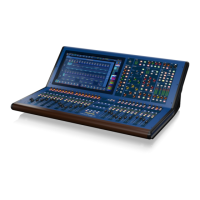267 HD96-24-CC-TP User Manual
The Bass EQ band can be switched from bell to any of three other shelving modes:
Warm, Classic, and Deep.
Filters
The dierence between the shelf lters is subtle and, if you do not have time to experiment, it is probably best to use classic because this is the best all round
lter. However, when you do have time to experiment you may nd the other types each have their uses. The minimum harmonic types, and in particular the bass,
can sound very natural, even with very aggressive EQ, but the psycho-acoustic principles that they operate on do not always work as well on multiple source or pre-
mixed material.
Soft treble
The soft treble response provides a very gentle gradient between EQ’d and non-EQ’d frequency areas. This produces the absolute minimum of phase shift but does
not provide much dierentiation, thus frequencies outside the area of interest are often unintentionally EQ’d. This is best used to provide gentle shaping of pre-mixed
material.
Classic treble
The classic treble response provides a much steeper gradient between EQ’d and non-EQ’d frequency areas, as made famous by previous Midas consoles like the XL4.
This provides better dierentiation and minimal phase shift, but there is some undershoot error, that is, when boosting the treble, the midrange is slightly cut and vice
versa. This is the best all round EQ and especially eective when microphones are covering multiple sources.
Bright treble
The bright treble response provides a slightly steeper gradient than the classic and it is uniquely shaped to provide minimum harmonic disruption to the EQ’d material.
As for the classic EQ, this provides better dierentiation and minimal phase shift, but now the mid-range is not changed as much. This lter is best used on single
source material and especially good for acoustic performances.
Warm bass
The warm bass response provides a very gentle gradient between EQ’d and non-EQ’d frequency areas. This produces the absolute minimum of phase shift, but does
not provide much dierentiation, thus frequencies outside the area of interest are often unintentionally EQ’d. This is best used to provide gentle shaping of premixed
material.
Classic bass
The classic bass response provides a much steeper gradient between EQ’d and non-EQ’d frequency areas and is modelled on the XL4. This provides better
dierentiation and minimal phase shift, but there is some undershoot error, that is, when boosting the bass, the mids are slightly cut and vice versa. This is often
desirable on bass EQ and it is the best all round, general purpose EQ curvature.
Deep bass
The deep bass response provides a slightly steeper gradient than the classic and it is uniquely shaped to provide minimum harmonic disruption to the equalised source.
As for the classic EQ, this provides better dierentiation and minimal phase shift, but there is no undershoot error. Powerful boost/cut can be used that still sounds
very natural and do not alter the mid-range. This is best used on single source material.
High Pass lter (HPF)
The HPF attenuates (not boosts) all frequencies below a certain level (cut-o frequency) while allowing all those above it to pass through. The harshness or
smoothness with which the sound is removed beyond this point is determined by the dB/octave, with 6dB being the most common. The HPF is generally used to take
rumble or hum out of any sound source but may also produce a sound eect by manipulation of the controls.
Low Pass lter (LPF)
The LPF attenuates (not boosts) all frequencies above a certain level (cut-o frequency) while allowing all those below it to pass through. The harshness or smoothness
with which the sound is removed beyond this point is determined by the dB/octave slope selection, with 6dB being the most common. The LPF is generally used to
reduce noise in quiet passages with excessively high frequencies but may also produce a sound eect, like a ltered drum roll, by manipulation of the controls.
Phase (All Pass Filter) Controls
The Variable Phase feature in each channel’s equalizer section allows the user to alter the phase of a signal by a variable amount. The eect works by using two all-
pass lters in series and controlling the center frequency of the lters to change the phase shift. The all-pass structure allows for a at magnitude-frequency response;
however, the lters delay dierent frequencies by dierent amounts resulting in a frequency-dependent phase shift.
Additional features have been added to this fundamental design by allowing control over the frequency range of the center frequencies via the High and Low settings.
High can be used on instruments and vocals with a frequency range in the upper audio spectrum. While Low is best used on instruments with a greater low frequency
content such as bass guitar or kick drum. The Phase Frequency Range allows a greater range of frequencies to be covered by the control. You can switch between a 0 to
90° or 0 to 180° phase shift range by using the 180/Deg or 90/Deg Phase Adjust Range buttons.

